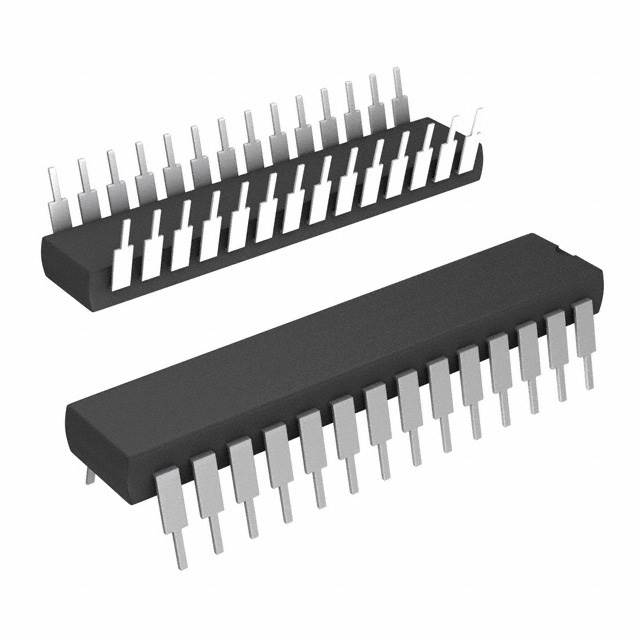Xem thông số kỹ thuật để biết chi tiết sản phẩm.

PIC16C76-10E/SP
Introduction
The PIC16C76-10E/SP is a microcontroller belonging to the PIC16C series, which is widely used in various electronic applications. This entry provides an overview of the PIC16C76-10E/SP, including its category, use, characteristics, package, specifications, pin configuration, functional features, advantages and disadvantages, working principles, application field plans, and alternative models.
Basic Information Overview
- Category: Microcontroller
- Use: Control and processing of electronic systems
- Characteristics: Low power consumption, high performance, versatile I/O capabilities
- Package: 28-pin DIP (Dual Inline Package)
- Essence: Embedded control and processing unit
- Packaging/Quantity: Single unit packaging
Specifications
- Operating Voltage: 2.5V to 6.0V
- Clock Speed: 10 MHz
- Program Memory Size: 7 KB
- RAM Size: 192 bytes
- I/O Pins: 22
- Timers: 3
Detailed Pin Configuration
The PIC16C76-10E/SP features a 28-pin DIP package with specific pin assignments for power, ground, I/O, and communication interfaces. The detailed pin configuration can be found in the datasheet provided by the manufacturer.
Functional Features
- Versatile I/O Capabilities: The microcontroller offers a wide range of input and output options, making it suitable for diverse applications.
- Integrated Timers: Built-in timers facilitate precise timing control in various operations.
- Analog-to-Digital Conversion: The microcontroller includes ADC modules for analog signal processing.
Advantages and Disadvantages
Advantages
- Low power consumption
- High-performance processing
- Integrated peripherals for diverse applications
Disadvantages
- Limited program memory size
- Restricted clock speed compared to newer models
Working Principles
The PIC16C76-10E/SP operates based on the Von Neumann architecture, where program instructions and data share a common memory space. It executes instructions fetched from program memory and interacts with external devices through its I/O pins and communication interfaces.
Detailed Application Field Plans
The PIC16C76-10E/SP finds applications in various fields such as: - Embedded Systems: Used for controlling and monitoring functions in embedded systems. - Automotive Electronics: Employed in automotive control units for engine management and sensor interfacing. - Consumer Electronics: Integrated into consumer products for user interface and control functionalities.
Detailed and Complete Alternative Models
- PIC16F877A: Offers enhanced features and larger memory capacity
- PIC18F4520: Provides higher performance and expanded I/O capabilities
- ATmega328P: A popular alternative from a different manufacturer with similar functionality
In conclusion, the PIC16C76-10E/SP is a versatile microcontroller suitable for a wide range of electronic applications, despite its limitations in memory size and clock speed. Its low power consumption and integrated peripherals make it a viable choice for embedded control and processing tasks.
[Word Count: 443]
Liệt kê 10 câu hỏi và câu trả lời thường gặp liên quan đến ứng dụng PIC16C76-10E/SP trong giải pháp kỹ thuật
What is the maximum clock frequency of PIC16C76-10E/SP?
- The maximum clock frequency of PIC16C76-10E/SP is 10 MHz.What are the key features of PIC16C76-10E/SP?
- The key features of PIC16C76-10E/SP include 8-bit CPU, 14-bit instruction word, and 33 I/O pins.Can PIC16C76-10E/SP be used in battery-powered applications?
- Yes, PIC16C76-10E/SP can be used in battery-powered applications due to its low power consumption.Is PIC16C76-10E/SP suitable for real-time control applications?
- Yes, PIC16C76-10E/SP is suitable for real-time control applications due to its high-speed processing capabilities.What programming language is commonly used for PIC16C76-10E/SP?
- Assembly language is commonly used for programming PIC16C76-10E/SP.Can PIC16C76-10E/SP interface with external sensors and actuators?
- Yes, PIC16C76-10E/SP can interface with external sensors and actuators through its numerous I/O pins.Does PIC16C76-10E/SP have built-in analog-to-digital conversion (ADC) capability?
- No, PIC16C76-10E/SP does not have built-in ADC capability and requires an external ADC if analog inputs are needed.What are the typical voltage requirements for PIC16C76-10E/SP?
- PIC16C76-10E/SP typically operates at a voltage range of 2.0V to 5.5V.Can PIC16C76-10E/SP communicate with other devices using serial communication protocols?
- Yes, PIC16C76-10E/SP supports serial communication protocols such as SPI and I2C.Are there development tools available for programming and debugging PIC16C76-10E/SP?
- Yes, there are various development tools such as MPLAB IDE and PICkit programmers available for programming and debugging PIC16C76-10E/SP.

